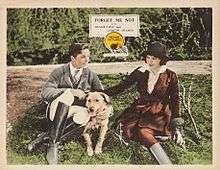Forget Me Not (1922 film)
Forget Me Not, also known as Forget-Me-Not,[3][4] is a 1922 American silent melodrama film directed by W. S. Van Dyke and distributed by Metro Pictures. The film starred Bessie Love and Gareth Hughes. It is considered a lost film.[1][5][6]
| Forget Me Not | |
|---|---|
 Lobby card | |
| Directed by | W. S. Van Dyke |
| Produced by | Louis Burston |
| Written by | Henry Roberts Symonds (story) John B. Clymer (adaptation) |
| Starring | Bessie Love Gareth Hughes |
| Cinematography | Arthur L. Todd |
| Distributed by | Metro Pictures |
Release date |
|
Running time | 6 reels;[1] 6,800 feet[2] |
| Country | United States |
| Language | Silent (English intertitles) |
Plot
_-_Love.jpg)
Young mother Mary Gordoon (Hunt) is too poor to take care of her infant daughter, and leaves the child at orphanage. The girl, Ann (Love) grows up with a crippled leg in the orphanage, and has fallen in love with a fellow orphan Jimmy (Hughes). The mother returns to the orphanage after 15 years to adopt her daughter, but believing her daughter to have been adopted by someone else already, she adopts Jimmy instead.
Ann is eventually adopted by a sidewalk musician (Lederer), who teaches her to play the violin. When Jimmy marries another girl, Ann plays at his wedding. Many years later, after Jimmy's wife dies, the pair are reunited.[2][7][8][9]
Cast
- Irene Hunt as Mary Gordoon, the Mother
- Will Machin as The Father
- Bessie Love as Ann, the Girl
- Gareth Hughes as Jimmy, the Boy
- Otto Lederer as Rodolfo, the Musician
- Myrtle Lind as The Other Girl
- Hal Wilson
- Gertrude Claire
- Sam Allen
- W. E. Lawrence
Production
Director W. S. Van Dyke was unhappy about the casting of Bessie Love in the lead, whom he had not chosen.[10]
In preparation for her role, Love lived at an orphanage for two weeks.[11]
Scenes were filmed at the Crooked Tree in Arch Beach, Laguna.[12]
The song "A Million Hearts Are Calling: Forget Me Not" with words and music by Billy Baskette and Ernest Lutz, was composed and published for the film.[13][14]
Reception
The film received generally positive reviews[15][16] and was commercially successful.[3][4] According to The Evening Mail, the film "is a fine, clean, beautiful picture… told with such depth of understanding and with entire lack of artificiality that it strikes its note of appeal as few films that have… It is blessed with a cast that could not be improved upon." The Daily News said, "Few who see this little screen drama will not soon forget its sweetness and charm."[2][7] The New York Times was critical of the film, deeming that it had only "one genuinely poignant moment."[17]
Of the performances, those of Love and Hunt, in particular, were praised.[3][9][15][16] The New York Times reviewer wrote of Hughes's performance that "it is always a pleasure to watch him" and that Love was "sometimes remarkably effective, though occasionally she simpers in an annoying manner".[17]
The film's use of intertitles was criticized.[2][3]
References
- Bennett, Carl (October 5, 2004). "Progressive Silent Film List: Forget Me Not". Silent Era. Retrieved November 8, 2017.
- "Sure Fire Appeal for Those Who Like Human Interest Stories". The Film Daily. July 23, 1922. p. 2.
- R.W. (October 28, 1922). "Current Reviews". Camera!. Vol. 5 no. 29. p. 7.
- "'Forget-Me-Not' Makes Big Success". Moving Picture World. October 7, 1922. p. 473.
- Munden, Kenneth W., ed. (1971). The American Film Institute Catalog of Motion Pictures Produced in the United States: Feature Films 1921–1930. New York: R.R. Bowker Company. p. 268. OCLC 664500075.
- "Forget-Me-Not". Library of Congress. November 8, 2017. Retrieved November 8, 2017.
- "Forget Me Not". The Evening News. Harrisburg, Pennsylvania. June 9, 1923. p. 19.
- Motion Picture News Booking Guide. New York, NY: Motion Picture News. April 1923. p. 51.
- Reid, Laurence (July 29, 1922). "Reviews of the Latest Features". Motion Picture News. p. 561.
- Behlmer, Rudy (1996). W.S. Van Dyke's Journal: White Shadows in the South Seas, 1927–1928: and Other Van Dyke on Van Dyke. Scarecrow Press. ISBN 978-0-8108-3028-8.
- "At the Theatres". Ellensburg Daily Record. February 17, 1923. p. 5.
- Sleeper, Jim (1980). "The Dear Johns". Great Movies Shot in Orange County. Trabuco Canyon, California 92678: California Classics. p. 103. OCLC 7358612.CS1 maint: location (link)
- "1922 Bessie Love Silent Film sheet music Forget Me Not Lost Film Million Hearts". eBay. Archived from the original on November 11, 2019.
- McFarland, Ken Wlaschin (2009). The Silent Cinema in Song, 1896–1929. ISBN 978-0-7864-3804-4.
- "Contemporary Criticisms". Camera!. Vol. 5 no. 17. August 5, 1922. p. 14.
- "'Forget-Me-Not' Is Approved". Motion Picture News. November 18, 1922. p. 2567.
- "The Screen". New York Times. New York, N.Y. July 24, 1922. p. 16.
External links
| Wikimedia Commons has media related to Forget Me Not. |
- Forget Me Not on IMDb

- Forget Me Not at AllMovie

- Forget Me Not at the TCM Movie Database

- Forget Me Not at the American Film Institute Catalog
- Forget Me Not at the British Film Institute
